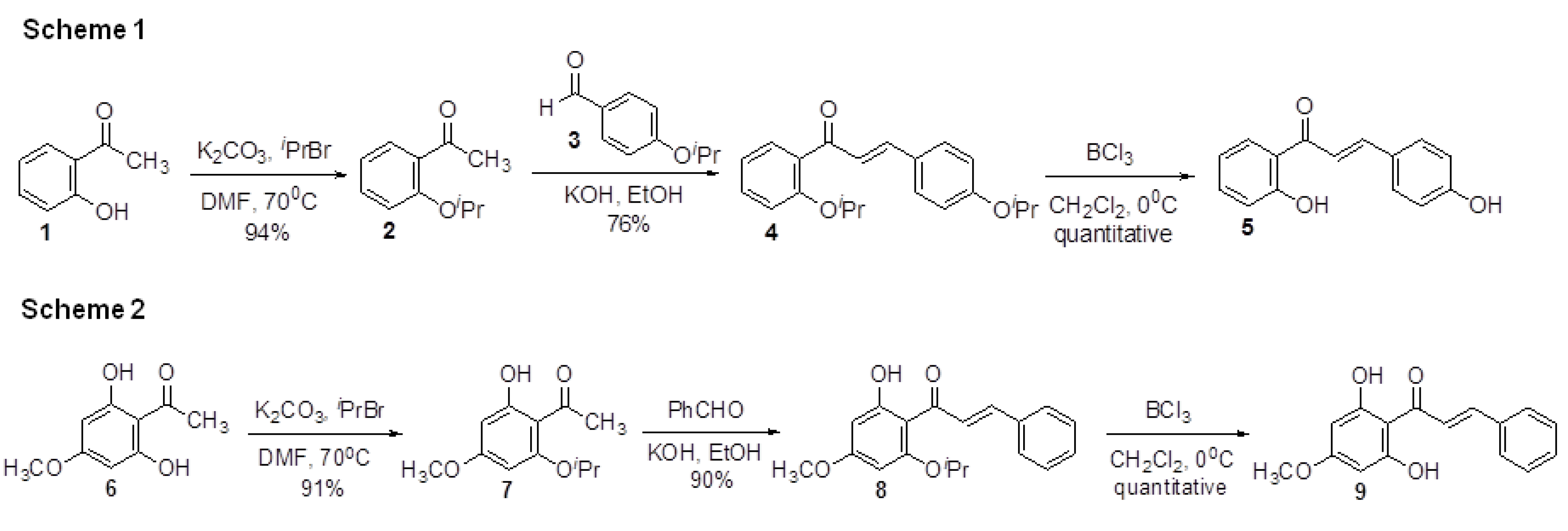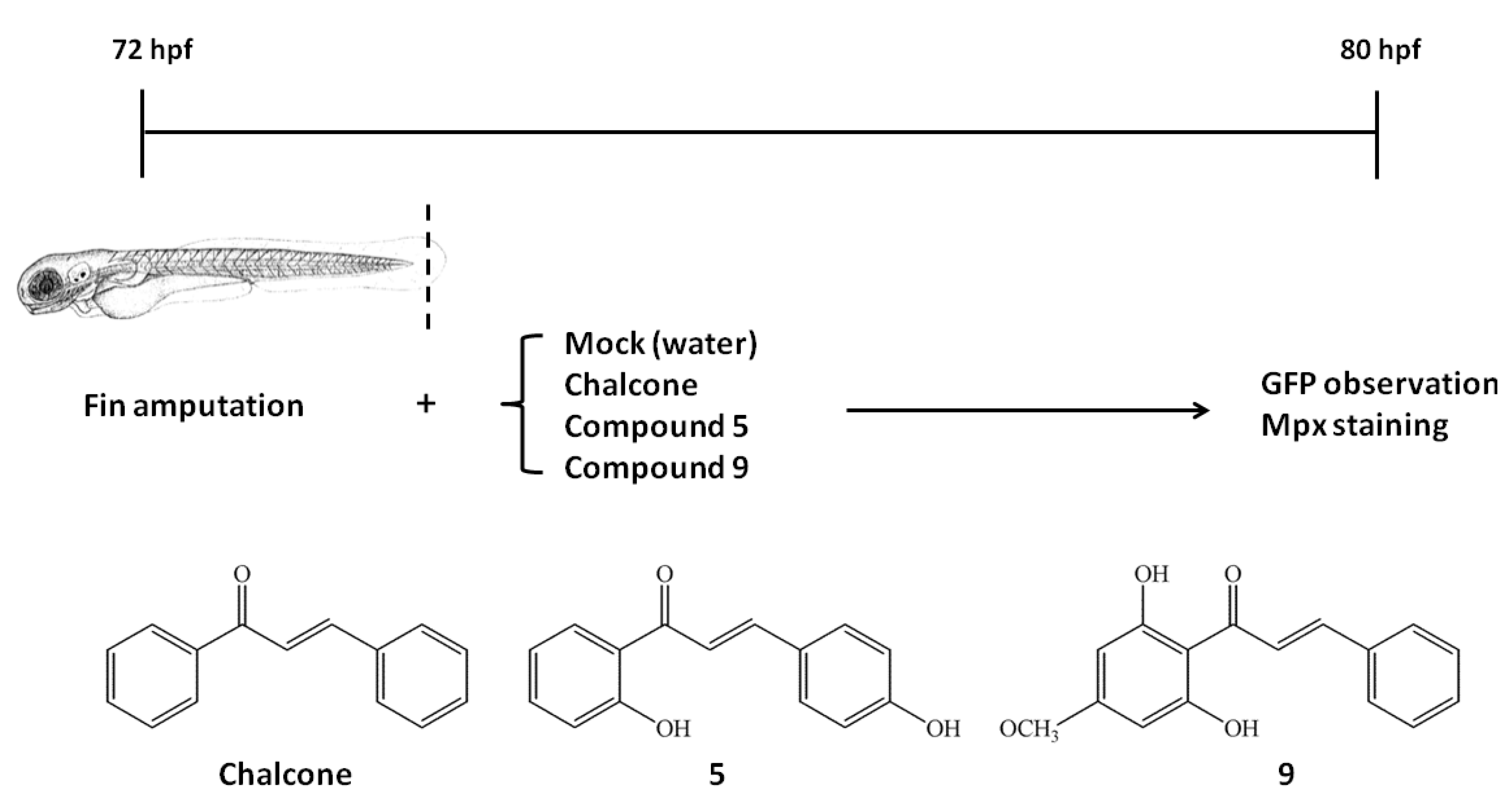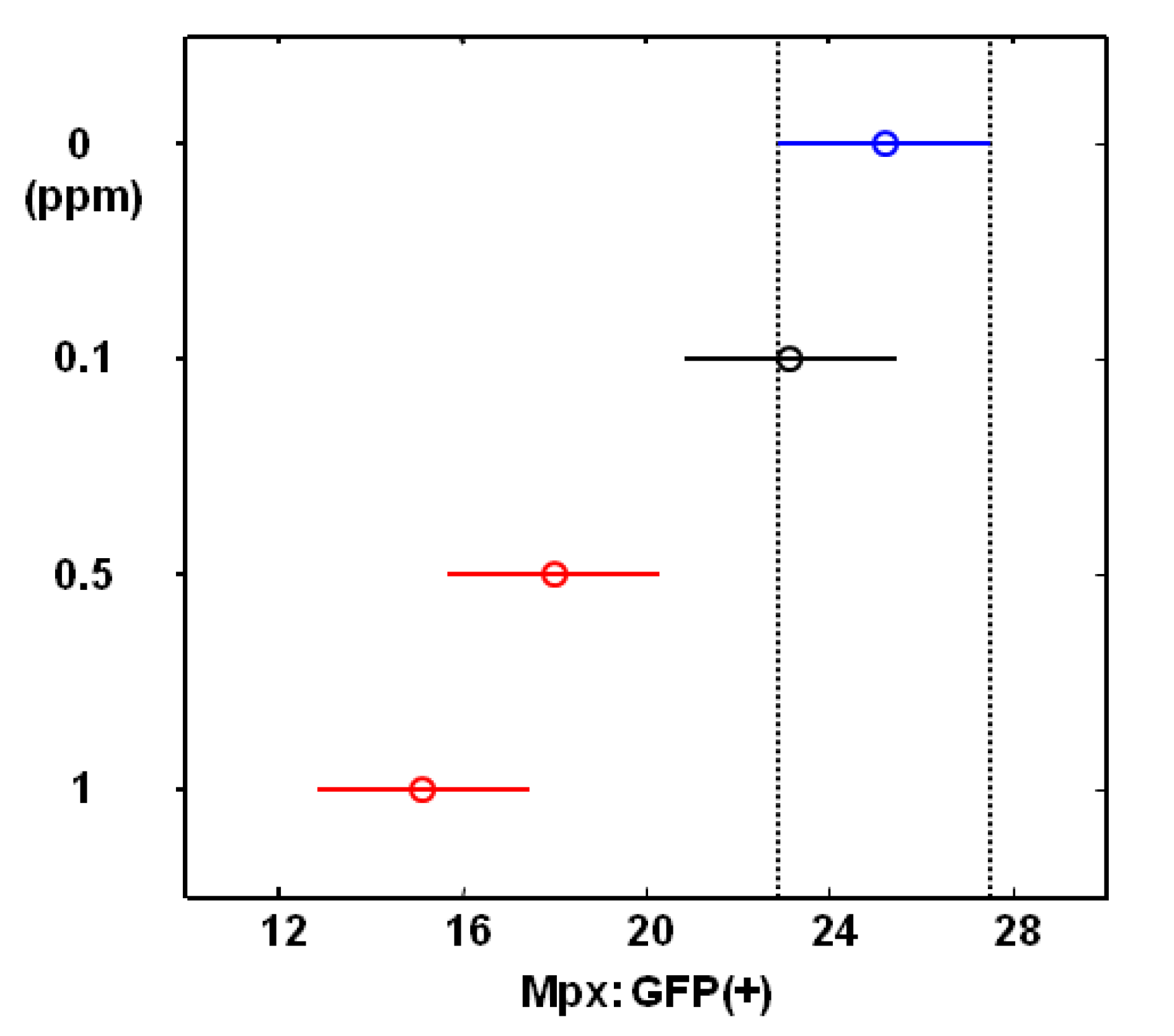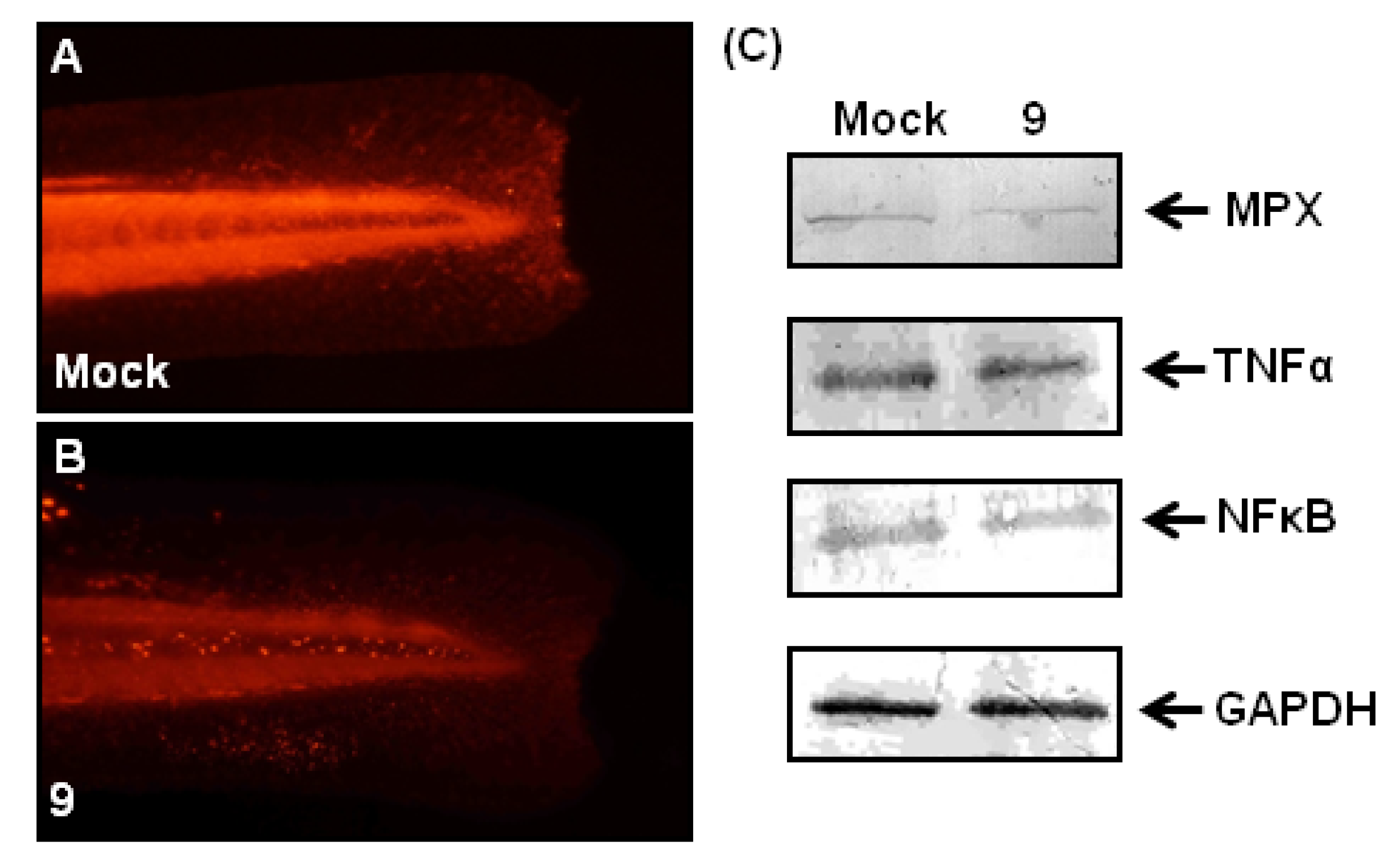Evaluation of the Anti-Inflammatory Effect of Chalcone and Chalcone Analogues in a Zebrafish Model
Abstract
:1. Introduction
2. Results and Discussion
2.1. Chemistry

2.2. Effects of Chalcones on Wound-Induced Neutrophil Recruitment and Mpx Enzymatic Activity




2.3. Molecular Mechanism of Anti-inflammatory Effects of Compound 9

3. Experimental
3.1. General
3.2. Synthesis of New Chalcone Analogues
3.3. Zebrafish Larvae, Fin Amputation and Chalcones Treatment
3.4. Myeloperoxidase Staining, Antibody Labeling and Western Blotting
3.5. Statistical Analysis
4. Conclusions
Acknowledgments
- Samples Availability: Samples of the compound 5 and 9 are available from the authors.
References
- Go, M.L.; Wu, X.; Liu, X.L. Chalcones: An update on cytotoxic and chemoprotective properties. Curr. Med. Chem. 2005, 12, 483–499. [Google Scholar] [CrossRef]
- Kontogiorgis, C.; Mantzanidou, M.; Hadjipavlou-Litina, D. Chalcones and their potential role in inflammation. Mini Rev. Med. Chem. 2008, 8, 1224–1242. [Google Scholar] [CrossRef]
- Kamal, A.; Ramakrishna, G.; Raju, P.; Viswanath, A.; Janaki Ramaiah, M.; Balakishan, G.; Pal-Bhadra, M. Synthesis and anti-cancer activity of chalcone linked imidazolones. Bioorg. Med. Chem. 2010, 20, 4865–4869. [Google Scholar]
- Bashir, R.; Ovais, S.; Yaseen, S.; Hamid, H.; Alam, M.S.; Samim, M.; Singh, S.; Javed, K. Synthesis of some new 1,3,5-trisubstituted pyrazolines bearing benzene sulfonamide as anticancer and anti-inflammatory agents. Bioorg. Med. Chem. Lett. 2011, 21, 4301–4305. [Google Scholar] [CrossRef]
- Kumar, V.; Kumar, S.; Hassan, M.; Wu, H.; Thimmulappa, R.K.; Kumar, A.; Sharma, S.K.; Parmar, V.S.; Biswal, S.; Malhotra, S.V. Novel chalcone derivatives as potent Nrf2 activators in mice and human lung epithelial cells. J. Med. Chem. 2011, 54, 4147–4159. [Google Scholar] [CrossRef]
- Bukhari, S.N.A.; Jasamai, M.; Jantan, I. Synthesis and biological evaluation of chalcone derivatives. Mini-Rev. Med. Chem. 2012, 12, 1394–1403. [Google Scholar]
- Bukhari, S.N.A.; Jantan, I.; Jasamai, M. Anti-inflammatory trends of 1, 3-Diphenyl-2-propen-1-one derivatives. Mini-Rev. Med. Chem. 2013, 13, 87–94. [Google Scholar]
- Wu, J.; Lee, J.; Cai, Y.; Pan, Y.; Ye, F.; Zhang, Y.; Zhao, Y.; Yang, S.; Li, X.; Liang, G. Evaluation and discovery of novel synthetic chalcone derivatives as anti-Inflammatory agents. J. Med. Chem. 2011, 54, 8110–8123. [Google Scholar]
- Witko-Sarsat, V.; Rieu, P.; Descamps-Latscha, B.; Lesavre, P.; Halbwachs-Mecarelli, L. Neutrophils: Molecules, functions and pathophysiological aspects. Lab. Invest. 2000, 80, 617–653. [Google Scholar] [CrossRef]
- Renshaw, S.A.; Loynes, C.A.; Trushell, D.M.; Elworthy, S.; Ingham, P.W.; Whyte, M.K. A transgenic zebrafish model of neutrophilic inflammation. Blood 2006, 108, 3976–3978. [Google Scholar] [CrossRef]
- Moorthy, N.S.H.N.; Singh, R.J.; Singh, H.P.; Gupta, S.D. Synthesis, biological evaluation and in silico metabolic and toxicity prediction of some flavanone derivatives. Chem. Pharm. Bull. 2006, 10, 1384–1390. [Google Scholar]
- Pouget, C.; Lauthier, F.; Simon, A.; Fagnere, C.; Basly, J.-P.; Delage, C.; Chulia, A.-J. Flavonoids: Structural requirements for antiproliferative activity on breast cancer cells. Bioorg. Med. Chem. Lett. 2001, 11, 3095–3097. [Google Scholar] [CrossRef]
- Chawla, H.M.; Chakrabarty, K. Dye-sensitized photo-oxygenation of chalcones. J. Chem. Soc. Perkin Trans. I 1984, 1511–1513. [Google Scholar]
- Liao, Y.F.; Chiou, M.C.; Tsai, J.N.; Wen, C.C.; Wang, Y.H.; Cheng, C.C.; Chen, Y.H. Resveratrol treatment attenuates the wound-induced inflammation in zebrafish larvae through the suppression of myeloperoxidase expression. J. Food Drug Anal. 2011, 19, 167–173. [Google Scholar]
- Westerfield, M. The Zebrafish Book, 3rd ed; University of Oregon Press: Eugene, OR, USA, 1995. [Google Scholar]
- Kimmel, C.; Ballard, W.W.; Kimmel, S.R.; Ullmann, B.; Schilling, T.F. Stages of embryonic development in the zebrafish. Dev. Dyn. 1995, 203, 253–310. [Google Scholar] [CrossRef]
- Kaplow, L.S. Simplified myeloperoxidase stain using benzidine dihydrochloride. Blood 1965, 26, 215–219. [Google Scholar]
- Chen, Y.H.; Lin, J.S. A novel zebrafish mutant with wavy-notochord: An effective biological index for monitoring the copper pollution of water from natural resources. Environ. Toxicol. 2011, 26, 103–109. [Google Scholar] [CrossRef]
- Chou, C.Y.; Hsu, C.H.; Wang, Y.H.; Chang, M.Y.; Chen, L.C.; Cheng, S.C.; Chen, Y.H. Biochemical and structural properties of zebrafish Capsulin produced by Escherichia coli. Protein Expr. Purif. 2011, 75, 21–27. [Google Scholar] [CrossRef]
- Lee, G.H.; Chang, M.Y.; Hsu, C.H.; Chen, Y.H. Essential roles of basic helix-loop-helix transcription factors, Capsulin and Musculin, during craniofacial myogenesis of zebrafish. Cell. Mol. Life Sci. 2011, 68, 4065–4078. [Google Scholar]
- Ding, Y.J.; Chen, Y.H. Developmental nephrotoxicity of aristolochic acid in a zebrafish model. Toxicol. Appl. Pharmacol. 2012, 261, 59–65. [Google Scholar] [CrossRef]
© 2013 by the authors; licensee MDPI, Basel, Switzerland. This article is an open-access article distributed under the terms and conditions of the Creative Commons Attribution license (http://creativecommons.org/licenses/by/3.0/).
Share and Cite
Chen, Y.-H.; Wang, W.-H.; Wang, Y.-H.; Lin, Z.-Y.; Wen, C.-C.; Chern, C.-Y. Evaluation of the Anti-Inflammatory Effect of Chalcone and Chalcone Analogues in a Zebrafish Model. Molecules 2013, 18, 2052-2060. https://doi.org/10.3390/molecules18022052
Chen Y-H, Wang W-H, Wang Y-H, Lin Z-Y, Wen C-C, Chern C-Y. Evaluation of the Anti-Inflammatory Effect of Chalcone and Chalcone Analogues in a Zebrafish Model. Molecules. 2013; 18(2):2052-2060. https://doi.org/10.3390/molecules18022052
Chicago/Turabian StyleChen, Yau-Hung, Wei-Hua Wang, Yun-Hsin Wang, Zi-Yu Lin, Chi-Chung Wen, and Ching-Yuh Chern. 2013. "Evaluation of the Anti-Inflammatory Effect of Chalcone and Chalcone Analogues in a Zebrafish Model" Molecules 18, no. 2: 2052-2060. https://doi.org/10.3390/molecules18022052
APA StyleChen, Y.-H., Wang, W.-H., Wang, Y.-H., Lin, Z.-Y., Wen, C.-C., & Chern, C.-Y. (2013). Evaluation of the Anti-Inflammatory Effect of Chalcone and Chalcone Analogues in a Zebrafish Model. Molecules, 18(2), 2052-2060. https://doi.org/10.3390/molecules18022052




